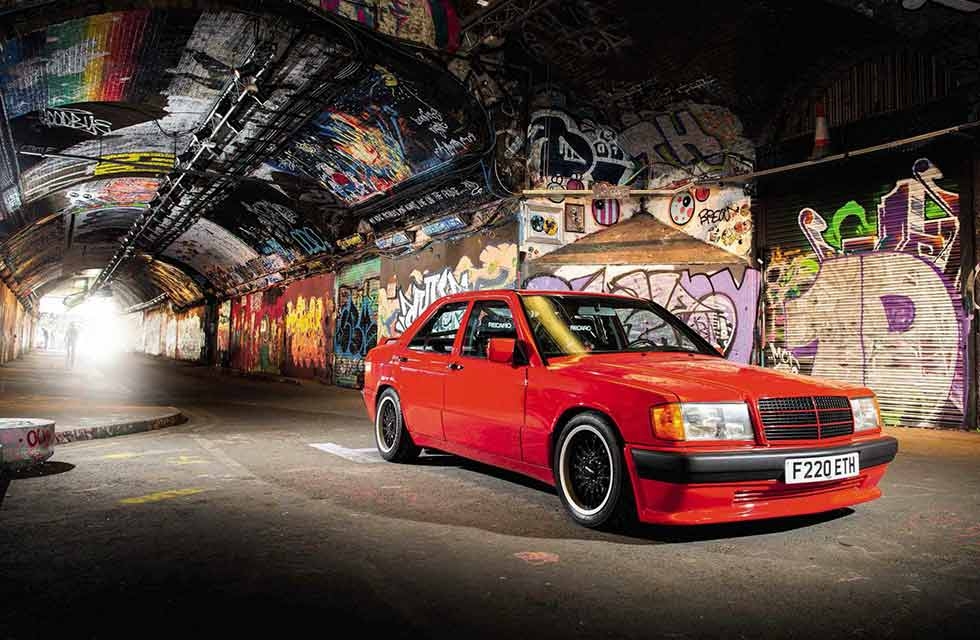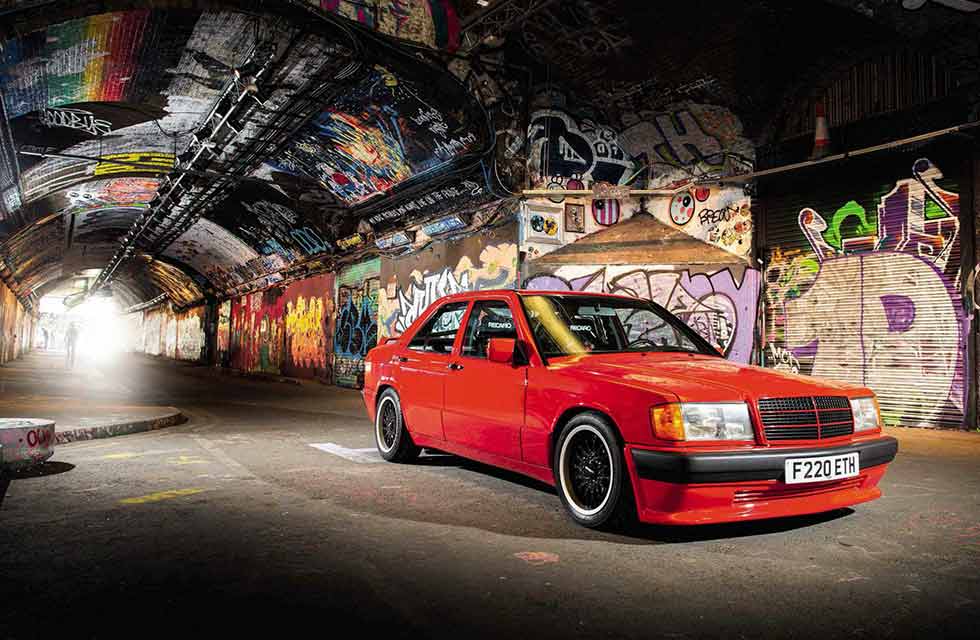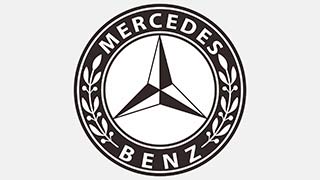
Brabus founder Bodo Buschmann made his name with cars like this tuned W201 Mercedes-Benz 190E – and inspired an entire industry. Here’s how. Words Dan Trent. Photography Paul Harmer.
EXCESS ALL AREAS 1989 Brabus Mercedes-Benz 190E 3.6S W201 an incredible tribute to Bodo Buschmann
The sight of a bodykitted 190 prowling South London streets might take some back to a less salubrious era of ‘rude Mercs’ and questionable 1980s excess. But this one is a bit different, not least thanks to its six-figure pricetag and recognition of what the Brabus badge on its bootlid stands for. It’s certainly getting plenty of positive attention from those not even born when such cars were enjoying their heyday, evidence of how far tuning has come being reflected in the fact that few seem fazed at its value. For them it’s just the peak of retro cool.
‘AMUSINGLY, GIVEN THE RACY SURROUNDINGS, IT STILL FEELS LIKE A W201 190 INSIDE’

From grassroots beginnings, Brabus founder Bodo Buschmann helped spearhead the German tuning industry’s transformation into respectability and introduced the mindset of huge horsepower and no-expense-spared individualisation into the mainstream. His creations might not have been to all tastes but there’s no denying the influence his excess-all-areas approach wielded over competitors and even the car industry as a whole. As a co-founder and president of the German tuning industry trade association VDAT, he was also a driving force in helping tuners evolve from cottage-industry modifiers into fully fledged manufacturers – a status Brabus now enjoys along with established names such as Ruf, Alpina and others. He was a big man with a big presence, and his force of character is very much embodied in the cars he built.
Buschmann died earlier this year, not long after his company celebrated its 40th anniversary. Celebrating his legacy from the wheel of one of its more extreme creations seems appropriate, even if a stripped and ’caged Mercedes-Benz 190E isn’t necessarily the most appropriate place in which to spend a hot day in congested London traffic.
I don’t care. As a long-time Mercedes fan and child of the ’80s I’m in my comfort zone, no matter the sweat that’s seeping through my shirt into the Kevlar-backed Recaro race seats. Certainly the kerbside response would suggest I’m in a car with a certain appeal.
If people don’t register the significance of the starless, colour-coded grille or Brabus badge, the gruff sound of a tuned straight-six offers some sense of what this car is about. A 190E 2.0 in mail-order GRP skirts this is not; the fit and finish befit a factory-built Brabus special. In stop/start traffic it coughs, splutters and grumbles, its gearing and fuelling calibrated for higher speeds than can be achieved here. It’s a purposeful and sophisticated sound though, harking back to an era when big engines, big valves and lots of air and fuel into the combustion chambers were the route to big horsepower.
While a track-influenced saloon with manual gearbox might not be typical of Brabus’s output, the attention-seeking ability very much is. As it did for Mercedes-Benz, the 190 W201 opened the door for Brabus to a new and younger audience. Stuttgart’s own performance variant was built with motorsport homologation in mind, the 16-valve 2.3-16 and its later 2.5 and Evolution derivatives successful in their own right, built originally for rallying and then Touring Car racing, where they provided a perfect foil for the mighty E30 M3. Revvy four-cylinder engines worked in that arena but, on the road, failed to deliver on the more muscular driving manners many craved. And so the door was opened to the tuners.
Buschmann started Brabus from the forecourt of his parents’ dealership in 1977 as a distraction from studying law and business. He was clearly onto something and the business quickly outgrew its original home and moved into its own premises. And the 190 was Brabuss path to creating a customer base all of its own. V8 conversions demonstrated an early taste for the monstrous engine upgrades that remain a Brabus trademark but Buschmann was smart enough to realise people needed a first step on the ladder. So he teamed up with Sixt rental and supplied them with 200 kitted-up 190s for an accessible, Hertz Mustang-style taste of tuning culture.
the inspiration for the one you see here was something a bit different. Built in the heat of the ’80s tuning boom and based around the straight-six 3.6S conversion, despite its stripped, track-focused interior, race seats and rollcage it was beautifully finished and detailed, which put a new twist on the Brabus tuning philosophy.
Not surprisingly it went down a storm with the motoring press, and journalists delighted in getting it sideways in clouds of tyre smoke, celebrating the idea of a Mercedes 190 with Porsche-chasing performance. But Brabus customers wanted horsepower with all the luxury trimmings and, after it had served its time, it was upgraded with a 24-valve head and converted back into a fully trimmed road car.
the story doesn’t end there though. Brabus PR man Sven Gramm joined the company long after the 190 had gone but stories of its existence and folders of press cuttings from Sport Auto and Auto Zeitung back in the day had him in the mood for an after-hours project. After a long search he found an elderly gent selling a suitable 190E 2.6 W201 with a manual gearbox, and that gave him the basis for the press special’s rebirth.
Gramm took his time over the build, doing much of the work himself. ‘We have a saying in German: Man wachst mit seinen Aufgaben. It means you grow with your work and learn as you go,’ he says.
Replicas and recreations might be a sticky- subject in some quarters but, with the original car long gone, Gramm was able to draw on the knowledge and experience of longstanding Brabus technicians who’d worked on the original. And when all’s said and done it’s a factory-built car, converted from a Mercedes and created to an individual spec. Which is exactly the same as any other Brabus, only based around an older car in this instance. Indeed, classic restorations remain an important – if less well-known – part of the business, and Pagodas and Gullwings are often displayed alongside six-wheeled G-Wagens W403 and 900bhp S-Classes on Brabus motor show stands.
This in-house expertise and passion proved a great help when it came to some of the trickier aspects of creating this car. ‘The guy who did the engines is still at Brabus,’ says Gramm, ‘and we found an original crankshaft and pistons to help with the conversion. I took a 3.0-litre M103 from a W124 E-Class and it was bored out here.
There was a lot of work and a lot of special parts like the spoiler with the oil cooler in the middle, which is handmade out of copper especially for this car. The manifold and the exhaust system we also had made and we modified the hydraulically controlled ASD locking differential to be more aggressive.’ Bored out from the standard 88.5mm to 92mm and with the stroke increased from 80.25mm to 90mm, the engine recorded an easy 268bhp on the Brabus dynomometer, even with deference to its freshly built state.
After some finishing touches one Friday night, Gramm returned the following morning to pick it up from the factory and bumped into the boss. ‘He said “the car is ready? You have to take me with you!”’ he recalls, this raised something of a problem though: Gramm had selected the smaller Recaro seats to fit within the cage. ‘Herr Buschmann was not the smallest guy, but he somehow got himself into the seat and as we drove a little way he was smiling and saying “I feel 20 years younger!”’
And today it’s not hard to see why this car made such a splash. Mercedes-Benz itself was no stranger to putting outrageously big V8s in luxury saloons – you need only look back at cars such as the 300SEL 6.3 W109 or 450SEL 6.9 W116 for evidence – but the idea of this track-ready 190 is amusingly incongruous, especially when you figure that it was bought in standard form from an elderly gentleman.
It’s a formula since imitated by in-house performance divisions BMW M and Mercedes-AMG, whose respective limited-edition M4 GTS F82 and Black Series versions of the CLK63 and C63 Coupe adopted a similar approach of artfully contrived minimalism.
Even VW has jumped on the bandwagon with its Nurburgring record-setting Golf GTI Clubsport S. A two-seat version of a regular hatchback? Well, the publicity value of halo cars and their popularity among superfans and collectors make them worthwhile even for mainstream brands.
this is a beautifully finished car, with braided oil lines, anodised fastenings, even a quilted leather mat to line the (now empty) spare wheel well. Same applies under the bonnet, where the red cam cover with its Brabus 3.6 script dominates a beautifully presented engine bay, with hoses, cables and ancillaries all neatly tidied and showing the care lavished on the build.
And it’s fabulous to drive. My route into London has taken in Surrey backroads and fast-moving dual carriageway. On the twistier roads the 190 feels small by modern standards, while the suspension – Eibach springs over Bilstein dampers, perhaps inevitably – ties it down like no regular 190 yet without being too harsh, the biggest revelation is the steering, which is still recirculating ball in the classic Mercedes style but which has been worked on to eliminate the usual slop and gives the baby Brabus an unexpected sense of agility.
There’s even something close to meaningful feedback over cambers and surface changes, not something you’d have got from any regular Mercedes of the era.
Amusingly, given the racy surroundings, it still feels like a 190. OK, you’re not usually seated in race-spec Recaros and it still comes as a shock when you look over your shoulder to see a rollcage where the rear seats should be. But the dashboard is the regular, subtly sculpted black plastic moulding, and the vibe remains faithful to the source material, albeit corrupted in spectacular fashion.
With a little room to get into its stride the straight-six has a chance to show its character. Its torque is the biggest difference between this and the 16-valve 190s, not to mention that inspirational exhaust note, the manual gearbox – a standard pattern rather than the dogleg of the 2.3-16 and 2.5-16 – makes it a more interactive experience, and you can ride the higher gears or downshift a cog or two as the mood takes you. Whatever gear you’re in, that sophisticated, Germanic six-cylinder tone is glorious.
Gramm took it on a couple of laps of the Nordschleife, which sounds like the dream ticket – far more enjoyable and appropriate than the M25. But it’s fun on the motorway too, thanks to that torquey response and long gearing, which together suggest that it would have the legs on more modern machinery on roads not troubled by gantry cameras and variable speed limits.
You could have enjoyed all that character and performance with all the interior intact and a full complement of seats, of course. And while there’s an amusing novelty factor about this car, I can appreciate the motivation for returning the original one to street spec in order to find a buyer.
That it existed at all is something of an anomaly, even in the world of extremes embodied by Brabus. But I’m glad it did and even more so that it was revived and can now stand as a tribute to Buschmann and the unapologetic approach to customisation he helped pioneer.
Modified cars aren’t for everyone, I realise. But when they’re done with such class and quality it’s hard to feel too stuffy. As a hero car for a generation of tuner specials, this is a spectacular celebration of a vibrant automotive culture that resonates to this day. And a piece of modern history, too.
THANKS TO Fast Classics, fast-classics.com, and to Sven Gramm at Brabus
TECHNICAL DATA FILE SPECIFICATIONS 1989 Brabus Mercedes-Benz 190E 3.6S W201
Engine 3590cc straight-six, OHC, Bosch fuel-injection
Max Power 268bhp @ 6000rpm / DIN
Max Torque 270lb ft @ 4800rpm / DIN
Transmission Five-speed manual, rear-wheel drive
Steering Recirculating ball, power-assisted
Suspension Front: MacPherson struts, anti-roll bar. Rear: multi-link. Custom Bilstein telescopic dampers and Eibach coil springs front and rear
Brakes Discs with ABS (Bosch 4-ch)
Weight 1340kg
Top speed 168mph
0-62mph 6.3sec
Clockwise from top right Tail spoiler and twin tailpipes are subtle clues to this 190E’s added power; interior is little changed up-front, bar race-style buckets – though rear bench has made way for a rollcage; 3.6-litre straight-six is good for an easy 268bhp and 168mph.






